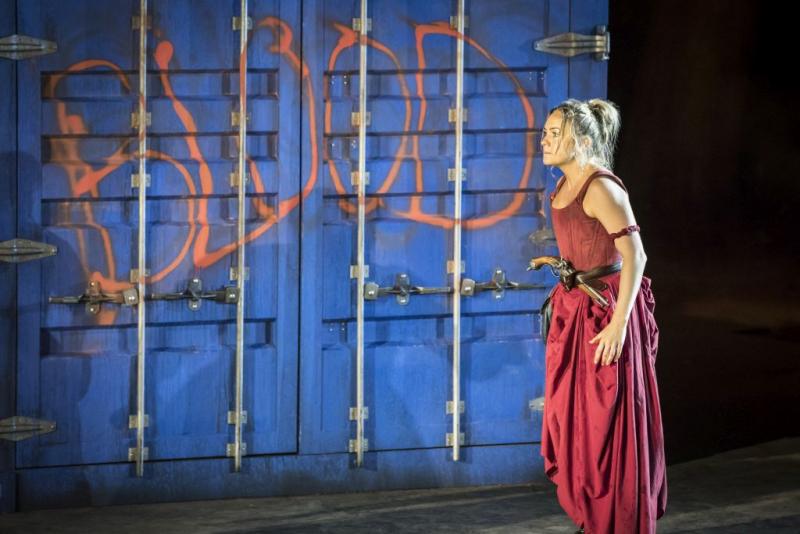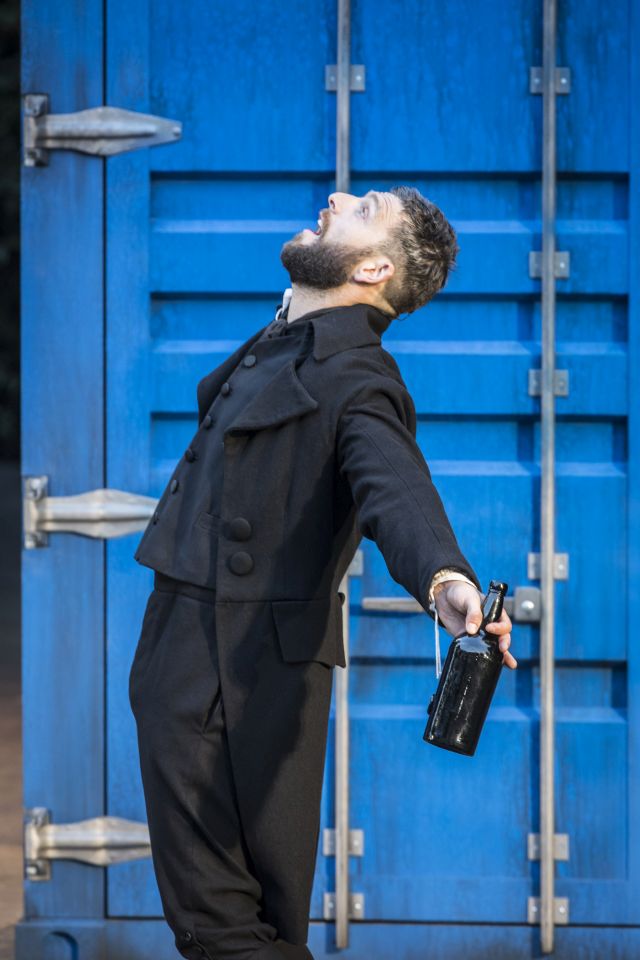A Tale of Two Cities, Regent’s Park Open Air Theatre review - it was the longest of times | reviews, news & interviews
A Tale of Two Cities, Regent’s Park Open Air Theatre review - it was the longest of times
A Tale of Two Cities, Regent’s Park Open Air Theatre review - it was the longest of times
Dickens adaptation succumbs to the didactic

Much loved, yes. But Dickens’s novel is probably little read by modern audiences and so a chance to see a new adaptation of this tale of discontent, riot and general mayhem set in the French revolution and spread across London and Paris in the late 1700s should be a genuine treat for theatregoers.
Adapting a novel for stage, though, is a frequently unsatisfying process once the text has been gutted to fit the parameters of time and space. Dunster and director Timothy Sheader kick off with the cast declaiming in turn one of literature’s most famous openers: "It was the best of times, it was the worst of times" etc. On the page, this sets the reader up to explore Dickens's dualistic themes, and also gives historical context of political and social turmoil to the period. But on stage it's just an uninspired regurgitation of prose, tricked up here with a variety of street and regional accents, and more than a nod to modern-day political leaders, demos, and refugee camps. (The two lookalikes from the novel are played by actors of different races.)
And this is a very, very long adaptation of Dickens’s tale of imprisonment, heroism, and redemption, at least for some. Indeed, on press night the performance was 15 minutes longer than it should have been since almost halfway through part of the set collapsed and the show had to be halted. Once regrouped, the cast felt more cohesive and in charge of proceedings, interestingly, than they had before.
 Nicholas Karimi (pictured right) is an admirable Sydney Carton and plays his abject part with ease; his double in the narrative, Charles Darnay, is here intriguingly played by a black actor, Jude Owusu: a casting decision that makes the audience work harder and scores its own political point. Both Kevork Malikyan as bank employee Jarvis Lorry and Patrick Driver as Dr Manette display gravitas and sympathy for their characters. But overall the inexperience of many of the cast is palpable, giving the play the air of amateur dramatics night filtered through the finishing school of EastEnders. (On a lighter note, a tip to actress Clare-Louise Cordwell, who plays the knitting-mad Madame Defarge: please learn to knit the Icelandic way. It will speed you up no end.)
Nicholas Karimi (pictured right) is an admirable Sydney Carton and plays his abject part with ease; his double in the narrative, Charles Darnay, is here intriguingly played by a black actor, Jude Owusu: a casting decision that makes the audience work harder and scores its own political point. Both Kevork Malikyan as bank employee Jarvis Lorry and Patrick Driver as Dr Manette display gravitas and sympathy for their characters. But overall the inexperience of many of the cast is palpable, giving the play the air of amateur dramatics night filtered through the finishing school of EastEnders. (On a lighter note, a tip to actress Clare-Louise Cordwell, who plays the knitting-mad Madame Defarge: please learn to knit the Icelandic way. It will speed you up no end.)
Difficult to pull off al fresco, the play would benefit from enclosure and the intimacy that creates. A more sympathetic design would better support the frantic leaps from Paris to London. As it is, three stacked shipping containers serving as prison, parlour and wine shop prove awfully cumbersome, whilst a good portion of the start offers a maelstrom of opening doors and a dizzying stage revolve. Over time the movement subsides and Fly Davis's set is better utilised, producing scenes of real pathos, such as Lucie waiting in the street hoping her husband will glimpse her from his prison cell.
Dunster and Sheader rarely leave anything to chance and give little room for the audience to think for themselves. The play’s closing brings the action, unnecessarily, into contemporary Britain. But those undeniable parallels with our own refugees and volatile political divisions don’t need spelling out. The closing homily on what Britain could be is less enlightening than embarrassing: more art, please, and fewer polemics.
rating
Share this article
The future of Arts Journalism
You can stop theartsdesk.com closing!
We urgently need financing to survive. Our fundraising drive has thus far raised £49,000 but we need to reach £100,000 or we will be forced to close. Please contribute here: https://gofund.me/c3f6033d
And if you can forward this information to anyone who might assist, we’d be grateful.

Subscribe to theartsdesk.com
Thank you for continuing to read our work on theartsdesk.com. For unlimited access to every article in its entirety, including our archive of more than 15,000 pieces, we're asking for £5 per month or £40 per year. We feel it's a very good deal, and hope you do too.
To take a subscription now simply click here.
And if you're looking for that extra gift for a friend or family member, why not treat them to a theartsdesk.com gift subscription?
more Theatre
 50 First Dates: The Musical, The Other Palace review - romcom turned musical
Date movie about repeating dates inspires date musical
50 First Dates: The Musical, The Other Palace review - romcom turned musical
Date movie about repeating dates inspires date musical
 Bacchae, National Theatre review - cheeky, uneven version of Euripides' tragedy
Indhu Rubasingham's tenure gets off to a bold, comic start
Bacchae, National Theatre review - cheeky, uneven version of Euripides' tragedy
Indhu Rubasingham's tenure gets off to a bold, comic start
 The Harder They Come, Stratford East review - still packs a punch, half a century on
Natey Jones and Madeline Charlemagne lead a perfectly realised adaptation of the seminal movie
The Harder They Come, Stratford East review - still packs a punch, half a century on
Natey Jones and Madeline Charlemagne lead a perfectly realised adaptation of the seminal movie
 The Weir, Harold Pinter Theatre review - evasive fantasy, bleak truth and possible community
Three outstanding performances in Conor McPherson’s atmospheric five-hander
The Weir, Harold Pinter Theatre review - evasive fantasy, bleak truth and possible community
Three outstanding performances in Conor McPherson’s atmospheric five-hander
 Dracula, Lyric Hammersmith review - hit-and-miss recasting of the familiar story as feminist diatribe
Morgan Lloyd Malcolm's version puts Mina Harkness centre-stage
Dracula, Lyric Hammersmith review - hit-and-miss recasting of the familiar story as feminist diatribe
Morgan Lloyd Malcolm's version puts Mina Harkness centre-stage
 The Code, Southwark Playhouse Elephant review - superbly cast, resonant play about the price of fame in Hollywood
Tracie Bennett is outstanding as a ribald, riotous Tallulah Bankhead
The Code, Southwark Playhouse Elephant review - superbly cast, resonant play about the price of fame in Hollywood
Tracie Bennett is outstanding as a ribald, riotous Tallulah Bankhead
 Reunion, Kiln Theatre review - a stormy night in every sense
Beautifully acted, but desperately grim drama
Reunion, Kiln Theatre review - a stormy night in every sense
Beautifully acted, but desperately grim drama
 The Lady from the Sea, Bridge Theatre review - flashes of brilliance
Simon Stone refashions Ibsen in his own high-octane image
The Lady from the Sea, Bridge Theatre review - flashes of brilliance
Simon Stone refashions Ibsen in his own high-octane image
 Romans: A Novel, Almeida Theatre review - a uniquely extraordinary work
Alice Birch’s wildly epic family drama is both mind-blowing and exasperating
Romans: A Novel, Almeida Theatre review - a uniquely extraordinary work
Alice Birch’s wildly epic family drama is both mind-blowing and exasperating
 The Producers, Garrick Theatre review - Ve haf vays of making you laugh
You probably know what's coming, but it's such great fun!
The Producers, Garrick Theatre review - Ve haf vays of making you laugh
You probably know what's coming, but it's such great fun!

Add comment